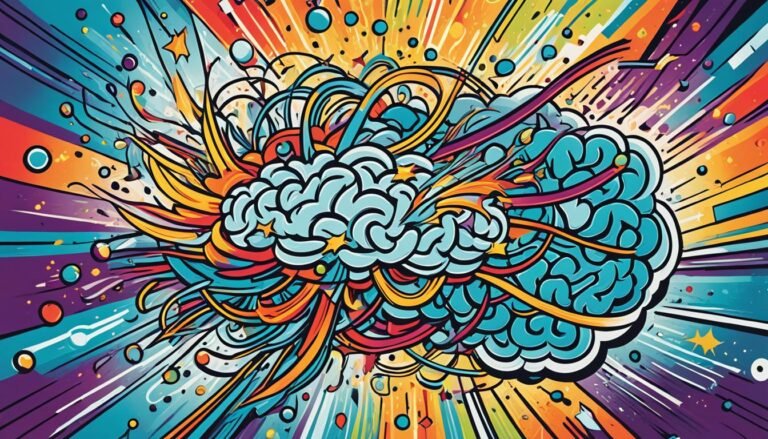Time Management Techniques for Creative Professionals
Time management is key for creative pros. They often handle many projects and deadlines at once. To do this well, they need to plan their time smartly. This means making time for both creative work and necessary tasks.
For artists, designers, and other creatives, staying productive is crucial. They need to set tasks in order of importance and use time blocking. This approach helps them work efficiently. It also reduces things that might draw their attention away.
Key Takeaways:
- Allocate dedicated time for creative projects
- Eliminate distractions to maintain focus
- Set realistic goals and prioritize tasks
- Track and analyze time usage for better productivity
- Take regular breaks to avoid burnout
The Importance of Managing Time, Energy, and Focus
Creative folks often find it hard to juggle their time, energy, and focus. They have lots of projects and tasks, and it’s easy to get overwhelmed. This can make it tough for them to know what to do first, leading to less time for their most important projects. As a result, they might not be as productive as they want to be. But, understanding how crucial it is to manage these three things can help them do better at their creative work.
When it comes to time, creative pros should break their day into focused chunks. This means dedicating specific times just for their creative projects. Doing this helps cut down on distractions, allowing them to dive deep into their work. It boosts their focus and improves what they produce. And don’t forget, taking breaks is just as valuable. It keeps you fresh, fuels creative ideas, and prevents burnout.
Energy is another big deal. To keep those creative juices flowing, it’s essential to stay active. Regular exercise is key. It gets the blood pumping, boosts your mood, and sharpens your mind. This way, creatives can stay energized and keep their thinking sharp.
Lastly, focusing on the right tasks is vital. Knowing what’s most important and doing those things first is a big part of managing your time well. Clear goals make it easier to stay on track. They help cut out distractions like phone notifications or trying to do too many things at once. This way, creatives can focus better, manage their time, and get things done more efficiently.
“The key to successful time management is not just managing the hours, but managing ourselves and our mindset.”
Benefits of Effective Time, Energy, and Focus Management:
- Enhanced productivity and output
- Improved quality of creative work
- Reduced stress and overwhelm
- Increased work-life balance
- Improved efficiency in completing tasks
Gaining control over your time, energy, and focus lets creative professionals achieve their best work. It’s key to see these as important sources of success. This approach can boost productivity, keep creativity flowing, and help hit your goals.
| Benefits of Managing Time, Energy, and Focus | Actions for Implementation |
|---|---|
| 1. Enhanced productivity | • Divide time into focused work sessions • Incorporate regular breaks for rejuvenation • Minimize distractions and multitasking |
| 2. Increased creativity | • Engage in physical exercise to boost energy • Refocus through mini-breaks and activities • Create an environment conducive to creativity |
| 3. Improved quality of work | • Prioritize important tasks and projects • Eliminate unnecessary distractions • Allocate time for deep focus and concentration |
Carving Out Time for Creative Work
Finding time for your creative projects can be hard. Sometimes, we wait for the perfect moment. We aim for long blocks of uninterrupted time to start our creative work. But, this leads to procrastination and delays. To fight this, we must set aside dedicated time for creativity. We should make this time a priority and set boundaries to protect it. By doing so, we ensure steady progress on our creative journey.
To make time for creativity, start by setting a schedule. Fill your calendar with time slots purely for your creative work. Then, stick to these appointments like they’re non-negotiable. With this time set aside, you can focus on your projects without any disturbances. This shows you’re serious about your creative endeavors. It’s a way to invest in what you love doing the most.
It’s crucial to protect your creative time by setting clear limits. Tell those around you that certain hours are off-limits for anything but your projects. By doing this, you keep your creative flow uninterrupted. Your creativity will thank you for it.
“Time is an artist’s most valuable resource. Protect it fiercely and make the most of every moment.”
Remember, creative work thrives even in small moments. You don’t always need big chunks of time. Be it an hour, a few minutes, or an evening, use any available time for your art. Each moment spent on your projects is valuable. This approach helps you steadily progress in your creative journey.
Ultimately, making time for creative work needs planning and commitment. Put your creative aspirations at the top of your to-do list. Guard your creative time and share your limits with those around you. This way, you honor your creativity by giving it the time and attention it deserves.
Benefits of Carving Out Time for Creative Work
Setting aside time for your creativity brings many benefits:
- Dedicated time leads to more productivity, focusing only on your projects.
- Giving time to creative projects sparks new ideas and inspiration.
- It lets you follow your passions, bringing joy and fulfillment.
- Regular time investment helps you improve and grow in your art.
- Seeing your projects move forward motivates you to keep creating.
For true growth in your art, it’s essential to make time for your creative work. Prioritize it, protect your time, and enjoy the journey of your creativity.
| Time Management Tips for Carving Out Time for Creative Work |
|---|
| Create a schedule |
| Set boundaries and communicate them |
| Make the most of small pockets of time |
| Protect your creative time fiercely |
| Remember the benefits of making time for your creative work |
Choosing One Project at a Time
Creative professionals are full of great ideas. But working on too many at once can be tough. It’s better to pick just one project to focus on. This way, they can do better work and finish it feeling proud.
It’s easy for creatives to want to do it all. Yet, focusing on one project is key for doing the best job. It helps avoid spreading too thin and not fully enjoying any project. This focused effort brings out the best in their work.
Focusing on one project makes work better. It lets them really dive into the details and make big progress. The result is work that’s not just done but really stands out.
Finishing one project brings a big feeling of success. This feeling pushes them to start the next project with energy. Jumping between projects can slow them down. They start loving to finish, not just start, their work.
Choosing one project doesn’t mean others are forgotten. It’s about picking what’s most important right now. After completing a project, it’s time to move on to the next.
This way of working is good for creators. It makes them more productive and gets to the heart of their ideas. With this method, their creative work really shines.
Balancing Money Work and Love Projects
Being a creative pro often means handling both personal and work-related projects. It can be hard to find a balance. But it’s crucial to fit both into your life. This way, you can chase your creative dreams while also meeting your financial needs.
It’s important to make time for work that brings in money. This keeps you financially stable. And it supports your passion projects on the side. Doing your job well lays a strong base for your creative aims.
Also, remember to cherish your creative passions. These projects define who you are as a creative. They let you try out new ideas and mediums. Doing these projects keeps your love for creativity alive.
Working on your personal projects helps you grow. It’s a way to improve your skills and find your unique style. These projects can bring you a lot of joy and professional success.
It takes smart planning to strike the right balance. Focus on tasks that are most important. Set goals that cover your money-making work and your creative adventures. This way, you’ll spend your time wisely.
Aim to match your income work with your passion projects. As you further your creative career, these personal projects might start to pay off. You get to do what you love and make a living from it.
Success comes from managing your work and personal projects well. It’s all about making your creative work support your financial goals. This balanced approach will help your creative career grow.
Tracking and Analyzing Time
Being creative, we need to keep a close eye on how time is spent. Tracking our activities helps us see when we’re most productive. Then, we can use this info to better manage our time.
One way to track our time is by recording how long different tasks take. This lets us spot any trends, like which tasks we might avoid. Knowing this, we can work on handling such tasks better.
Time tracking also improves our ability to guess how long tasks will take. Looking at the time we give to each task helps us plan our days more accurately. So, we end up with a schedule that’s more realistic.
Plus, tracking our time can clue us in on when we are usually at our best. This way, we can plan to do our toughest tasks when we have the most energy. And for when energy is low, we can set aside easier tasks.
Understanding Productivity Patterns
By keeping an eye on our time use, we can find out when we’re super productive. We can also see what helps us get a lot done. This knowledge is key to setting up our work environment in the best possible way.
“Time tracking empowers creative professionals to become more aware of their work habits and make data-driven decisions about how to manage their time effectively.” – Jane Smith, Creative Director at XYZ Studio
Time tracking can also shake up our thinking about how we work. It can show us areas where we can do better. This way, we get better and faster at what we do.
Creating an Effective Time Management Strategy
With the insights from time tracking, we can get smarter about how we plan our time. We learn to do the most important tasks when we’re at our best. And we get rid of things that waste our time.
Looking closely at how we spend time might point out tasks we could give to others. Tasks that take up a lot of time but don’t add much value could be handed off. This would give us more time for our main creative work.
To sum it up, keeping track of our time can really help us do better. We learn our best and worst times for working. This helps us plan our time in ways that bring greater success and creativity.
Avoiding Multitasking and Distractions
Multitasking and being distracted are big obstacles for creative workers. It’s key to focus deeply on one task to avoid losing creativity. To do this, it’s important to stay away from doing too many things at once and to get rid of things that might break this flow. Doing these things can help creative people work better and come up with more ideas.
Staying Focused with Time Blocking
Time blocking is a great way to avoid doing many tasks at once and to keep focused. It means assigning certain times just for working on specific jobs. This method reduces the chances of getting distracted by things like email or social media. It also allows for long, uninterrupted times to really get into the creative zone and boost productivity.
Creating a Distraction-Free Work Environment
A workspace without distractions is essential. It helps creative workers stay on task. Removing things that can cause a distraction, like clutter or loud noises, is a good start. Also, using tools like noise-canceling headphones can block out unwanted sounds. Plus, letting others know when you can’t be disturbed can make a big difference.
Setting Boundaries and Communicating Effectively
Setting limits and telling others about your work time are critical. This way, friends, family, and coworkers know you need to concentrate. By laying down clear rules and having dedicated times for work, disturbing interruptions can be lessened. This helps in creating a work-friendly atmosphere that supports your creative efforts.
Utilizing Focus-Enhancing Techniques
There are many ways to keep focus and avoid doing too many things at once. For example, the Pomodoro Technique suggests a cycle of 25 minutes of work followed by a short break. This approach helps avoid getting tired while keeping on task. Techniques like deep breathing or mindfulness can also clear your mind and boost your focus during work.

“The ability to concentrate and use your time well is everything.” – Lee Iacocca
To be as productive and creative as possible, it’s crucial for creative folks to steer clear of multitasking and distractions. Focus on activities like time blocking, creating a clean workspace, and setting well-defined rules. These methods, along with focus-boosting techniques, will foster deep concentration and let creativity thrive.
Prioritizing Tasks and Setting Realistic Goals
Managing time well is key for creative pros. They need to sort tasks and set goals that are real. This helps them break big projects into smaller parts for better time use. Doing this makes their work more focused and organized.
They should find what’s urgent or important. Things that need quick action are urgent. Yet, tasks that help them reach big goals are important. By seeing what needs attention first, they make sure they’re on top of the most important stuff.
It’s big for creative folks to set real goals. This looks at their skills and stops them from taking on too much. Setting goals they can actually meet helps them avoid stress. They can then focus on creating great work when they don’t feel overwhelmed.
“Setting goals is the first step in turning the invisible into the visible.” – Tony Robbins
Delegating tasks is also important. Knowing when to let others do things helps them stay on what they’re best at. This stops them from getting too much to do. Using help from other experts or teams makes sure they work efficiently without being overloaded.
Benefits of Prioritizing Tasks and Setting Realistic Goals:
- Maximized productivity: Organizing tasks well helps creative professionals use their time and effort better, leading to more work done.
- Reduced stress: Realistic goals and good work planning ward off stress and burnout for these pros.
- Improved focus: Prioritizing helps creative pros stick to what’s really important. This means less time wasted on things that don’t matter much.
- Enhanced time management: Breaking down work and setting timelines let creative professionals handle their time better, meeting deadlines without a rush.
Sorting tasks and setting right goals is crucial for time management in creative fields. With these steps, they can keep their eyes on the main goals. This way, they won’t feel stressed and will move closer to their creative dreams.
Taking Breaks and Avoiding Burnout
It’s easy for creative professionals to forget about breaks. Yet, taking breaks is key for staying productive. It also helps us avoid feeling burnt out. By having regular breaks, we give our minds time to relax.
Taking breaks allows us to recharge and refocus. New ideas often come when we’re resting. This leads to creative breakthroughs.
Walking or exercising during breaks can boost creativity and well-being. Studies show exercise improves how our brains work and mood. It’s a great chance to clear our heads and see things differently. Being active benefits our creativity and our health.
A balanced work-life schedule is vital for long-term success. Breaks help avoid burnout and keep our careers enjoyable. Prioritizing rest makes our work more fulfilling.
Taking breaks doesn’t mean we’re lazy. It shows we value being more productive and keeping our creativity alive. Challenge yourself to take breaks, and watch as you come back to work with new vigor.
Creating a Dedicated Workspace
Being a creative pro means having a spot just for work. This lets you work without the fun and chaos of normal life. It helps boost how much you get done, makes you more creative, and keeps you on track with your goals.
Your special work area makes it clear when it’s time to focus. This way, you can easily get into the right mindset. It gets rid of distractions you might find in a shared space.
Here are some tips for making a great workspace:
- Create a designated area: Pick a place only for your work, like a nook or small room. What matters is it’s always ready for you to be creative.
- Eliminate distractions: Keep your space neat to avoid getting off track. Also, think about how to make it quieter. Maybe use headphones to block out noise.
- Create an inspiring environment: Fill your space with things that get your creative juices flowing. Add art, plants, and good lighting to make it feel right.
- Personalize your space: Add things that are special to you. Having your own stuff there can help make it feel like your place.
- Set boundaries: Talk to those at home about when you need to focus. This way, they’ll know to give you space when you’re working.
“A well-designed workspace is like a blank canvas; it’s a space where your creativity can thrive.”
Your workspace isn’t just any spot. It shows how serious you are about your work. Separating your work and chill spots helps boost how much you get done. It encourages a creative and productive mind.
Conclusion
Managing time well is key for creative people to do their best work. They should prioritize tasks and set achievable goals. This helps them reach their creative dreams and do well in what they do.
Good time management cuts down on putting things off and getting distracted. It also helps balance their creative and personal life.
Time management boosts a creative person’s output and creativity. Using methods like focusing on one task at a time and deciding what’s most important can help a lot.
By using these time management skills, creatives can be their best. They can fulfill their creative dreams while still having a balanced life.
For people in creative fields, managing time and energy well is vital. It’s not just about finishing to-dos. It’s about making sure they give their creative work the thought and energy it deserves.








